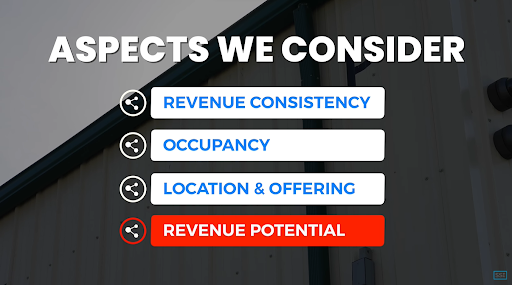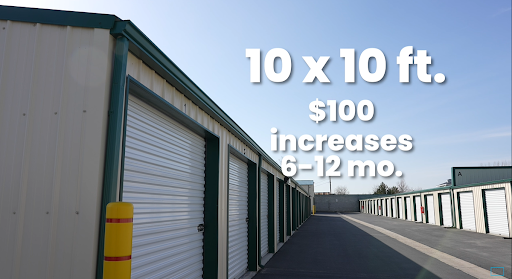
How to Increase Revenue in Self Storage Investing
Nov 17, 2023Self-storage Revenue: How to Increase and Maximize Your Earnings
One of the crucial factors contributing to our success in the self-storage industry is our ability to boost self-storage revenue. It's not just a matter of acquiring and holding properties; it's about actively managing and operating these assets. We view self-storage as a business, not just an investment. Our goal is to be actively involved in enhancing revenue because in the realm of self-storage, which falls under commercial real estate, increasing revenue directly translates to an increase in value.
Why Self-Storage is a Lucrative Asset Class
Self-storage is a particularly unique asset class, and what sets it apart is its remarkable revenue-generating potential, which surpasses that of most other asset classes. This is why we are so passionate about it and why we have achieved such significant success. It's a meaningful and fast-paced industry, and it offers a hedge against inflation, primarily due to its lease structure. With month-to-month leases and a constant influx of customers, self-storage behaves more like a retail business than a traditional "lease and forget" asset class. It's precisely this characteristic that provides us with the opportunity to rapidly and significantly boost revenue.
Revenue Potential: What to Look for When Buying a Self-Storage Facility
When you're looking to buy a self-storage facility, there are many things to consider, such as the consistency of revenue, occupancy, location, and what the facility is offering. However, one of the main focus areas you should be looking at is revenue potential. This means analyzing the current revenue and determining what it can be. The more revenue potential there is, the more opportunity there is for you to make money.

There are a few dead giveaways that you can look for when assessing the revenue potential of a self-storage facility. The first thing to look for is whether they are doing static pricing. Static pricing is when the facility charges a fixed price for its units, regardless of market conditions or demand. This is not an effective way to improve revenue, and it's one of the first things that should be changed.
-
Dynamic Pricing: The Key to Increasing Revenue
Dynamic pricing, much like the approach used by airlines and hotels, involves constant monitoring of market conditions and the current availability of units. The aim is to set prices based on demand, ensuring we can maximize our revenue while also avoiding vacant units, which would result in lost income each month.

This is a balancing act that self-storage facilities should always be looking at, as they don't want to leave money on the table, but they also don't want to be so out of line that nobody is coming to rent from them.
A dynamic pricing strategy is crucial for self-storage facilities. Failing to adjust prices adequately can either leave money on the table or lead to losses due to incorrect pricing. Revenue management and dynamic pricing can be as straightforward or as intricate as necessary. For instance, let's consider a specific unit size, such as a ten by ten. In traditional self-storage setups, the price for a unit is determined by its size, e.g., a ten by ten unit costs a fixed amount, like a hundred dollars.
However, our approach differs. We price units based on the demand for each unit individually. Not all ten by ten units are priced the same; each unit has its unique price, influenced by supply and demand factors. As these ten by ten units fill up, demand increases; when vacancies arise, demand decreases. We consider factors like special offers, rate increase schedules, and current market conditions for each individual unit. Pricing depends on the unit's unique supply and demand dynamics, the availability of units, pricing of other units, and market conditions.
This approach ensures that we strike a balance between optimizing revenue and staying competitive. Our prices are in a constant state of flux, reflecting the ever-changing market conditions and the individual characteristics of each self-storage facility. Furthermore, seasonality plays a role in our pricing strategy. While we have advanced software to assist with this, the fundamental approach is as simple as maintaining a spreadsheet with all our unit prices and continuously monitoring and adjusting them based on market conditions, competition, and our facility's unique offerings.
Every market and storage facility is unique. Storage facilities often offer units that have distinct features not found elsewhere in the market. For instance, climate-controlled units should be priced differently from standard units, and the price per square foot should not be the same.
2. Adding Lines of Revenue
Each market and storage facility is unique, with some storage facilities offering units that are not available elsewhere. For instance, climate-controlled units should be priced differently from standard units based on their specific features, rather than a uniform rent per square foot.
In addition to adjusting unit pricing, there are multiple ways to enhance revenue. This can involve diversifying the services and products offered within the facility. For instance, services like insurance, box sales, and other ancillary offerings can be introduced to create additional income streams.
To illustrate, consider U-Haul rentals at a storage facility as an example. Many storage operators rent out U-Haul trucks at their facilities, allowing them to share in the rental income and thereby establishing a new revenue stream.
Furthermore, you can expand your revenue sources by offering items such as boxes, crates, packaging materials, and packaging services. Tenant insurance is another significant source of income, as you often receive a portion of the insurance premium, contributing as much as 10-15% to the gross revenue. By implementing these strategies, you can quickly establish new and vital revenue sources for your facility.
3. Rate Increases
Now, last but certainly not least, we have rate increases. Rate increases aren't covered under revenue management; they pertain to how you handle and manage existing tenants once they're in at a given price. This approach varies depending on market conditions but not to the same extent.
Rate increases are implemented on an individual basis. Every tenant, regardless of when they moved in, receives a rate increase every 6-12 months, with the specific increase varying based on demand and conditions in our facility and the market. As different tenants move in at different times, these increases occur continuously, leading to organic revenue growth.

When a tenant moves out, our goal is to promptly replace them, usually at a higher street price. Our pricing strategy, guided by revenue management, ensures that we maintain competitive rates. It's important to avoid having a wide discrepancy between the rates charged to existing tenants. This divergence can be explained by the difference between physical occupancy and economic occupancy.
For instance, a facility may appear fully occupied, charging a uniform rate of $100 for all ten by ten units. However, not every tenant is paying this rate; some may have moved in at a lower rate, let's say $50, and never received rate increases despite the street rate going up. As a result, the average rental rate remains at $50, even though it could be marketed at $100. This situation represents a missed revenue opportunity and exemplifies the distinction between occupancy and economic occupancy.
Rate increases are essential, and they should be personalized and ongoing. Every tenant should receive rate increases regularly, which are tailored to their individual circumstances. These increases depend on both the demand within the facility and the broader market conditions. During peak seasons like early summer and spring, when demand is higher, more significant rental rate increases can be justified. In contrast, during slower periods, more modest increases are appropriate.
The key principle is not to adopt a "lease up and walk away" model with standardized pricing. Facilities that do follow this approach represent our acquisition targets because they can yield substantial profits. These are the primary methods we employ to increase revenue at our storage facilities, and you can implement them effectively as well.
Conclusion
In conclusion, maximizing self-storage revenue is a critical element of success in this unique and lucrative asset class. Diversifying revenue streams by using a dynamic pricing strategy, adding lines of revenue, services and products, such as insurance, box sales, and rental opportunities like U-Haul trucks, can significantly enhance earnings. Regular rate increases tailored to individual tenant circumstances also contribute to organic revenue growth, ensuring that existing tenants pay competitive rates and economic occupancy aligns with physical occupancy.
In the ever-evolving self-storage market, understanding the nuances of revenue management and employing these strategies can lead to substantial profits and success in this thriving industry.


